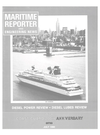
U.S. Coast Guard Celebrates 200 Years Of Service
Although formed under the Treasury Department from the Lifesaving Service and Revenue Cutter Service in 1915, the roots of the U.S.
Coast Guard can be traced to August 4, 1790. It all began with a request by the Secretary of the Treasury, Alexander Hamilton, to Congress for the authorization of the construction of 10 revenue cutters to stop smugglers trying to evade payment of import taxes.
This gave birth to the Coast Guard and earned Secretary Hamilton the title of "The Father of the Coast Guard." Besides their smuggler interdiction duties, revenue cutter sailors had to battle pirates and privateers, and enforce U.S. quarantine laws.
As the nation grew, larger and more heavily armed cutters were built and used in the country's first war—the Quasi-War with France (1797-1801). In the 1800s, revenue cutter sailors fought in the War of 1812, the Mexican-American War, the Civil War and the Spanish American War. For instance, in the War of 1812, the Revenue Cutter Vigilant captured the British privateer Dart, which had seized nearly 30 American vessels.
Revenue cutters fought on both sides of the Civil War. The Revenue Cutter Harriet Lane opened the Civil War's naval conflict, when it fired the first maritime shot at the steamship Nashville in Charleston Harbor.
A revenue cutter rescue at Cardenas Harbor, Cuba, was one of the most dramatic incidents in the Spanish-American War in 1898.
While under fire from shore, the Revenue Cutter Hudson towed the damaged USS Winslow to safety.
The Life Saving Service, formed in 1848, and Bureau of Navigation, begun in 1838, became key to the service's safety mission. They eventually joined the Revenue Cutter Service and the Lighthouse Service, begun in 1716, to form today's U.S.
Coast Guard.
Federal lifesaving stations were first built in 1848 and daring surfmen carried out a number of dramatic rescues. In 1889, for example, Ramus Midgett single-handedly waded through the treacherous surf of North Carolina's Outer Banks to rescue all 10 passengers and crew from the barkentine Priscilla. The surfman even saved the ship's dog.
A key mission of the Lighthouse Service has been and continues today (under the auspices of the Coast Guard) to be accident prevention.
Lighthouse keepers have guided ships into the nation's harbors since colonial times.
The Coast Guard's environmental responsibilities also have a long history.
Beginning in 1890, the Revenue Cutter Bear introduced a herd of reindeer to Alaska to help supplement the Eskimo food supply. The International Ice Patrol was established after the sinking of the Titanic, and today, Coast Guard aircraft still patrol the busy, fogshrouded, ice-laden waters between the United States and England.
The modern Coast Guard began in 1915 when the Revenue Cutter Service and the Lifesaving Service merged and took the name Coast Guard. The Lighthouse Service joined in 1939. The Bureau of Navigation and Steamship Inspection Service joined in 1942.
The Coast Guard served during World War I, as well as in the Roaring '20s in the battle against rum runners.
During World War II, the Coast Guard underwent its greatest expansion, growing to more than 240,000 members. The vast majority were reservists. The Coast Guard played a vital role in the North Atlantic convoy duty and landed soldiers and Marines on the beaches during every major amphibious operation.
Signalman First Class Douglas Munro, who lost his life rescuing a company of Marines at Guadalcanal, was awarded the Medal of Honor. He was the only coastguardsman so honored.
By the end of World War II, the Coast Guard was a true multimission service. It broke ice, marked rivers, helped with flood relief, and continued ocean patrols, aiding ships and planes in distress and providing vital weather information.
Ice operations expanded after the war. In 1957, the cutters Storis, Bramble and Spar began Arctic ice operations by crunching through the Northwest Passage. This proved that ships that were building the Distant Early Warning Line, a series of radar stations, could escape to the east if necessary.
Coastguardsmen fought on foreign shores once again, during the Vietnam War, to block seaborne supply routes. With Coast Guard cutters patrolling, a small wooden sampan had only a small chance of getting through, while a steel-hulled vessel had none at all.
During the 1970s, a series of oil tanker accidents led to an expansion of the Coast Guard's marine safety mission. The Coast Guard created Pollution Strike Teams and greatly increased the ship inspection and pollution monitoring programs.
The 1980s opened with a nonstop search and rescue case—the Cuban boat lift. More than 225,000 Cubans jammed into boats of every conceivable size, shape and condition and fled Cuba for the United States.
Many had to be rescued.
In 1980, Coast Guard pilots assisted by U.S. Air Force and Canadian pilots carried out one of the most dramatic helicopter rescues in history. When the cruise ship Prinsendam caught fire off the coast of Alaska, helicopters flew to the limit of their range and saved all of the more than 500 passengers and crew.
The Coast Guard Auxiliary has been a vital part of the service's safety mission. Since it was formed in 1941, the auxiliary has taught boating safety courses to thousands of people, conducted numerous boat safety inspections, and assisted the Coast Guard with search and rescue efforts.
The Coast Guard was started as a law enforcement agency and in the 1980s, the service is still at it. The Coast Guard enforces fisheries laws in the frigid New England and Alaskan waters and stops illegal migration in southern waters.
Stopping entry of illegal drugs is the Coast Guard's largest law enforcement mission today. The Coast Guard has intercepted thousands of cargoes of marijuana and cocaine.
As it begins its third century of service, the Coast Guard remains Semper Paratus—Always Ready— to enforce U.S. laws and respond to future challenges in the maritime region. •
Read U.S. Coast Guard Celebrates 200 Years Of Service in Pdf, Flash or Html5 edition of July 1990 Maritime Reporter
Other stories from July 1990 issue
Content
- Wartsila Diesel Announces Executive Appointments page: 10
- Chandris Celebrity's 'Horizon/ Built By Meyer Werft, Makes Her New York Debut page: 11
- Furuno Introduces New Autopilot, Compact, Lightweight Gyrocompass, And 10-Inch Color Video Sounder page: 11
- Radio Holland's Datamation: A Complete Integrated Ship Management System page: 13
- McDermott Awarded $27-Million Exxon Contract For Offshore Platform page: 13
- Avondale To Bid On Construction Of World's Largest Passenger Ship page: 14
- Singmarine Wins $16 Million Contract For New Chemical Tanker page: 15
- Hamilton Introduces Advanced Water Jet For Wide Range Of Vessels page: 16
- Halter Marine To Convert Supply Vessel For EPA Under $4.2-Million Pact page: 18
- Magnavox Introduces New Integrated GPS/Transit Satellite Navigation System page: 18
- Leevac Shipyards A w a r d ed Supply Boat Contract page: 19
- DIESEL POWER REVIEW page: 20
- MARINE LUBRICANTS page: 28
- U.S. Coast Guard Celebrates 200 Years Of Service page: 33
- Our Third Century page: 34
- Overview Of Coast Guard's Fiscal Year 1991 Request page: 36
- Willard Marine Continues Work With U.S. Coast Guard; Introduces SOLAS-Approved 18-Foot RIB page: 42
- Bollinger Receives $73.4-Million Modification To Build USCG Patrol Boats page: 42
- Morgan Crane Receives Order For Knucklebooms For Three Corvettes page: 43
- New Navy Report Outlines Potential Submarine Threat From Third World Nations page: 44
- US Navy Homeports Select Seaward Marine Fenders page: 44
- NORSHIPCO Completes Conversion of Crane Ship (T-ACS 9) For Navy page: 45
- Tano Marine Named Single System Vendor For T-AGS 45 page: 45
- Marinette Marine Launches Its Third MCM Vessel USS Patriot (MCM-7) page: 46
- Essex Machine Works Delivers New Steel Propeller Shafts For Coast Guard's 'Eagle' page: 48
- Viking Seminar Updates Skills of Service Representatives page: 48
- Global Marine Group Changes Company Name To GMG Systems, Inc. page: 53
- Robert Allan-Designed Hydrographic Survey Vessel Delivered By Allied Shipbuilders page: 54
- Aluminum Boats Constructing 140-Foot Dinner Yacht For Chicago page: 54
- Bender Awarded $3-Million Contract For Drill Rig Repair page: 55
- Cummins Diesels Power Cruise Vessel 'America' Delivered By Marine Builders page: 56
- ZF Introduces New Series Of Economical High-Horsepower Marine Transmissions page: 56
- $13-Million, Five-Boat Contract Completed By Moss Point Marine With Delivery Of Tugs To Jordan page: 58
- Deutz MWM Diesels To Power Four Harbor Tugs For Mexico page: 58
- Atlantic Marine Awarded $12.6-Million Contract To Build Three Sternwheel Dinner Vessels page: 59
- ABB Marine To Supply $50-Million Power Package To Fincantieri page: 59
- Blount Marine Delivers 192-Foot Dinner/Excursion Boat M / V Spirit Of Boston page: 60
- Canadian Government Report And New U.S. NOAA Administrator Publish Strong Swath Endorsements page: 61
- Master Marine Completes Repair, Maintenance On USCG Island Class Patrol Boats page: 62
- Trinity Marine To Build Three 220-Foot Supply Boats Under $15-Million Contract page: 62
- MTU-Powered High-Speed Catamaran, Built To New Flying Cat Design, Delivered By Kvaerner Fjellstrand page: 63
- COMSAT Expands Its Mobile Communications To New Ocean Region page: 63
- New Paint Factory For Sigma In Amsterdam page: 64
- Allied-Signal 'Spectra Shield' Panels For Marine Vessels Offer Maximum Ballistic Protection page: 64
- Textron Marine Systems Wins $6.5-Million Contract To Build Two SES Fireboats page: 65
- Congressional Conferees Near Compromise On Double-Hull Tanker Phase-In page: 66
- New Literature Available On Coffin Mechanical Seals For Turbo Pumps page: 67
- ABB Offers Eight-Page, Full-Color Brochure On Turbochargers page: 68
- Marco Shipyard Christens Fourth North Pacific Freezer Longliner page: 68
- Versatile Pacific Shipyards Uses N e w Launching Technique For Hydrographic Survey Ship page: 69
- L&C Associates Completes Deactivation Of M / V Cape Inscription page: 70


